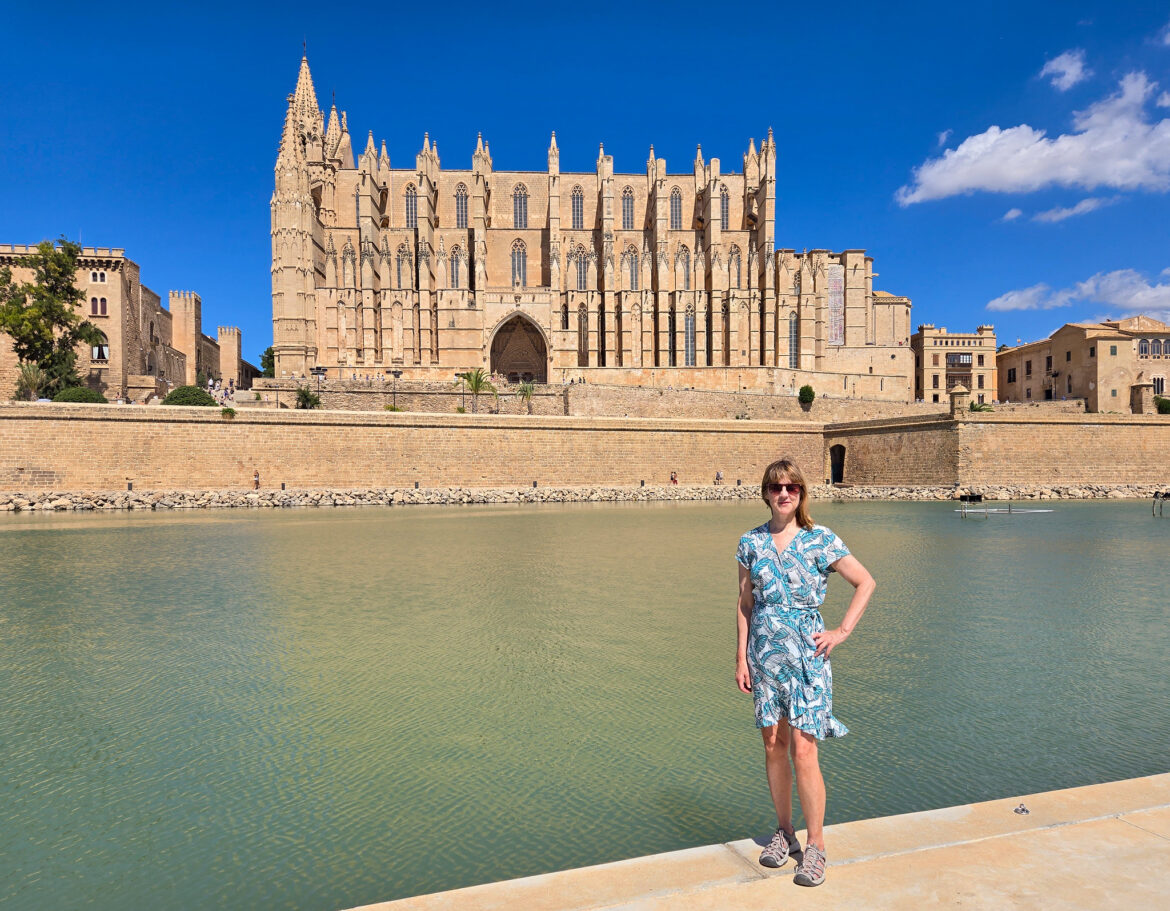Palma de Mallorca enchants and takes you back in time. The city’s history and art comes alive through the iconic architecture and art. Perhaps, there’s no better way to catch the true tempo of a place then a walking tour. After visiting many times, I walked everywhere (except Joan Miro Studio) in this guide. Love sharing my travel tips. So, I compiled this list of top Palma de Mallorca highlights tour on foot.
The beautiful Palma de Mallorca is the capital and largest city of the Balearic Islands in Spain. It’s located on the southern coast of Mallorca on the Bay of Palma. Palma was discovered as a Roman camp and later raided by the Vandals during the fall of the Western Roman Empire. Then, the Byzantine Empire, the Moors and James I of Aragon conquered it.
Check out my YouTube Video!
Palma de Mallorca Highlights Walking Tour
La Seu or Cathedral of Santa Maria of Palma
You can’t miss the incredible Gothic, sandstone Roman Catholic Cathedral, La Seu. It was built on a previous mosque over 600 years. The famous architect, Antoni Gaudi made the 20th-century renovations. It displays one of the world’s largest rose windows. Tours go inside the cathedral and up to the roof top terraces and bell tower. The Royal Palace of La Almundaina stands right next door.
Royal Palace of La Almundaina
Next to La Seu, the Royal Palace of La Almudaina is the official summer residence of the Spanish royal family. The building is a restoration of a Muslim Alcazar or fortified palace. The current structure is the same as the 14th century one built with the palaces of the King and Queen and chapel of Saint Anne.
On the ground floor, the medieval style is decorated with works from the 15th to 20th centuries. The upper floor is used for the celebration of official events by the Royal Family. It’s decorated by artifacts from the royal sites of the 17th, 18th and 19th centuries.
Parc de la Mar
The Parc de la Mar lies between the cathedral and Mediterranean Sea. It’s a wonderful place to wander while looking at the cathedral reflections on the artificial lake.
Benches, cafes and restaurants line up along the promenade to take in the perfect view of the cathedral and palace.
Old City
The Old City lies in the southeast area of Palma behind the cathedral. The pedestrian streets are a maze taking you back to the Arabic past. It’s fun to explore and get lost in the narrow, quiet streets surrounded by historic buildings.
In the Old City, the Banys Arabs or Arab Baths are open for tours to learn about the Arabic past and cultural ritual the hammam. Also in the Old City is the Ajuntament (Town Hall) and Convent de Santa Clara with gardens. Also, in the outside is the pedestrian walkway, similar to Barcelona’s La Rambla.
Palau March Museum
Palma de Mallorca Highlights Tour
In the heart of the city, the Palau March Museum sits behind the cathedral and palace. It was the residence of the March family and headquarters for their foundation. This art museum houses famous works from masters, such as, Salvador Dali and Rodin.
At the entrance is the 20th century sculpture courtyard with pieces from artists, such as, Rodin, Chillida and Moore. The monumental vestibule displays lithographs from the famous Spanish painter, Salvador Dali. Jose M. Sert became one of the most famous muralists of the 20th-century. Some of his last works included the murals in the music room and entrance for D. Juan March Ordinas.
Other artifacts and artworks include collections of Mallorcan cartography, a Renaissance window and 18th-century Neapolitan Nativity Scene.
Walk through a Pine Forest to Bellver Castle
The 14th century, Gothic-style Bellver Castle is one of the few circular castles in Europe. Just 3 km west of Palma, it stands on top of a pine-forested hill with panoramic views. It was built for King James II of Palma. Over the years, it was many things, such as, royal residence, refuge from the plague and prison. Today, the castle houses a historical museum of Mallorca. A walk winds through the forest up the hill to the castle. Also, a café with viewing deck is on site.
Walk or Cycle along the Waterfront Promenade to Portixol
A wide promenade and cycle path stretches for miles along the waterfront. A half hour walk takes you to Portixol (little port), a gentrified old fishing village. It also offers a nice beach, restaurants and marina.
Joan Miro’s Studio
The artist, Joan Miro spent his childhood in Mallorca and later made it his permanent home in the 1950’s. Joan Miro was a painter, sculptor and ceramicist. His work is mostly classified as a Surrealist artist with nuances of Fauvism and Expressionism. In Palma, he created his own art studio with gallery, sculpture gardens and classrooms. He worked in the studio until his death in 1983. It lies on the edge of town up on a hill with incredible views of the city and harbor below.
City Beach (C’an Pere Antoni)
Palma’s City Beach is walking distance from the city center. It stretches for a half-mile with white sands and clear waters. There are 2 beach clubs for renting beach chairs and umbrellas: Upmarket Nassau Beach Club and Anima Beach Club.
Enjoy Palma de Mallorca!
This city is a historic gem with incredible architecture and art alongside the sparkling Mediterranean Sea. This island is a multi-cultural blend with its Roman, European and Arabic past. The historic landmarks, culinary scene, art, shopping and beaches offer something for everyone. If your travels take you to Palma de Mallorca, please leave comments below on how to best enjoy this unique destination.
Read Next!
Charming Ajaccio, Corsica Walking Tour Highlights
The Iconic & Historic Rock of Gibraltar Highlights Tour










